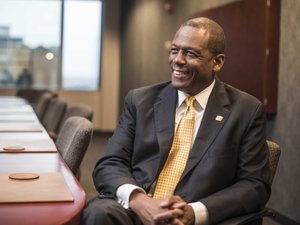
There are some CEOs in the banking industry who have a strong understanding of the technology and startup worlds, and then there are those who share a background similar to that of Tim Spence.
Long before he became the president and CEO of Fifth Third Bank (Nasdaq: FITB), Spence had several business cards working in the early 2000s for Clarity Visual Systems, a digital display and signage startup based in his hometown of Portland, Ore., in what is known as the “Silicon Forest.”
Spence was fresh out of college and working for the company in various capacities, including finance, corporate development and sales and marketing – before seeing the company have a successful exit in 2006.
“When you are operating in a business that’s burning cash, you wake up every day and say, ‘What is it that we need to do in order to ensure that we extend our runway?’” Spence told Courier sister outlet, Louisville Business First. “There’s a clarifying aspect to working in a startup environment that doesn't always exist in businesses that are scaled and inherently profitable.”
Although his days of raising capital at a startup are behind him, he still approaches his current role, which he began in July 2022, with a similar mentality in terms of always embracing tech-driven change.
“Having had the opportunity to spend a formative part of my own career in an environment where we were providing hardware and software solutions for business designed to replace legacy modes of doing things, you learn a lot about how to think about business strategy in the context of new capabilities, which I think is very valuable," Spence said.
He added he still wants his employees to be what he categorized as “general athletes” of the ever-changing banking world and not just specialists – or as he put it later “more range than expertise.”
“You find that in general, people with a broad range of skills and a lot of different frames that they can use to analyze problems tend to do better,” he said.
He used Kimberly Halbauer, Fifth Third's Kentucky regional president, as an example. Halbauer started on the retail side of the operation, before moving on to commercial division and later wealth and asset management before her current role as market president.
Halbauer, meanwhile, gave Spence a large share of the credit for getting Fifth Third involved as an active player when it came to collaborating and acquiring (in some instances) fintech companies to bolster its digital services.
Since Spence joined Fifth Third as an executive vice president and chief strategy officer at its Cincinnati headquarters in 2015, the bank has either invested in or owned part of approximately 25 fintech companies, acquiring five fintech startups outright. That includes this week's acquisition of fintech Rize Money and Fifth Third's recently completed purchase of Big Data Healthcare.
AI: "extremely useful" to employees
As Spence pointed out, Fifth Third Bank had a history of innovation long before his arrival. In 1977, for instance, the bank was the first to have a shared network of ATMs through a “kernel of software.” Before that, it was also the anchor bank for the rollout of the payment networks of Visa and MasterCard in the Midwest.
“What we hadn’t really done was to make the leap from hardware to software in terms of the mode of differentiation … What we hadn’t done was to adopt this idea that we could use software to actually change the role that products played in people's lives,” Spence said.
Since the implementation of those fintech startups, Spence said he has helped save the bank’s commercial banking customers a total of $32 million in “hard, operational expenses” through just managed services (accounts payable, invoice payments, etc.).
So what does Spence think about artificial intelligence (AI) and the role it can play in banking?
While there headlines have swirled about AI technology canceling – or threatening to cancel – back-end jobs previously done by people, Spence called AI a “very useful tool” that can serve as “extremely useful assist to your employees.”

For about two years, Fifth Third has run a program called MyDay which, among other offerings, gives an individually tailored recommended top 15 things to do that day for each bank employee that would help better manage their particular part of the business.
He added the average banker is managing somewhere in the vicinity of 750 relationships. It does this by running approximately 200 “machine-based algorithms overnight every night” as well as a corresponding optimization engine. The application also runs the customer-facing 53.com interface.
Earlier this year, Fifth Third was named to Fortune’s list of America’s Most Innovative Companies for 2023, the first time it received that recognition in its history.
“The AI is optimizing for the lifetime value of the customer relationships,” said Spence, who added MyDay has resulted in around a 27% increase in productivity since it was launched two years ago. “Retaining your customers and making sure they’re satisfied is the single biggest lever at our disposal.”
Spence said as a country, the U.S. needs AI to boost its collective productivity given the overall future job outlook.
“I think some of the debate that has gone on in the public domain is more academic than it needs to be,” he said. “More people will retire every year for the next decade-plus, than will graduate from high school or college in the U.S. in the same year, and the byproduct of that is, if you want the economy to stay the same size or grow, and your number of workers declines, we need these tools, in order to be able to do more.”
Spence had a few other comments on general banking matters:
On the lending environment:
“It’s definitely tighter than it was last year and tighter than it would have been at the beginning of March. It’s natural for lending conditions to tighten, as the (Federal Reserve) raises interest rates … to restrict supply or demand … I think what happened with the tech banks, having failed and the concerns over liquidity is you're seeing much more of a supply-driven slowdown to credit now because banks are saying, ‘I need to make sure that I retain enough in the way of liquidity to service existing clients,’ which means for new clients credit’s a little bit harder to come by.” NOTE: Fifth Third was one a few banks that made a bid to purchase First Republic Bank following its collapse. The FDIC eventually accepted a bid by JPMorgan Chase.
How the lending environment has affected Fifth Third:
"In our particular case, we did the majority of the tightening that we felt we needed to do last year, so we came into this year with the lowest expectation for loan growth among any of the large banks – and our outlook really hasn't changed dramatically, but that is, in part because we have really outstanding liquidity. We're the only one of the large cap banks who has actually grown deposits from June 30 of last year through the end of the first quarter … We were proactive about lending and therefore, we’re very much open for business. I think we are running on at a pace right now to eclipse our prior record in terms of new middle market relationships ($20 million to $1 billion) – and I think we’re gonna get that done in Kentucky this year, too.”
On the current interest rate situation:
“I think the market is overly optimistic about when the Fed starts cutting. Our house view has been that the Fed would have to hold rates higher for longer in an effort to get inflation down … I continue to hear from clients that they're not done passing through input costs or labor cost or overhead cost increases. And when you’re in that cycle, it means that the Fed has a ways to go. I would not be surprised if they hold at 5.25 (percent) – where they’re at now – or if they go up one more quarter point, and maybe hold at that level, and certainly not begin cutting at the end of this year, which is what the market currently anticipates.”
On any shifts of priorities for 2023 with the recent bank runs:
“Our goal is to be the best, when the times are worse, right? … Because we all know in our personal lives, that the best relationships are the ones that are there for us when things are hard – and we want to be there for our clients during difficult periods. We want to be a source of strength, a source of stability … And then in our industry, the majority of the outperformance that you generate for investors gets generated in times of uncertainty. Banks that navigate those periods the best … are capable of adding new relationships and driving really great, stable, profitable growth for their clients.”
On the importance of the bourbon industry to Fifth Third’s overall portfolio:
"Bourbon is a priority for us. In the state of Kentucky, we have a number of really wonderful, long standing relationships … We have spent a lot of time thinking through how to develop products, in particular, on the capital solution side of the equation, that are designed for businesses with a profile that the bourbon industry does … There are a lot of sectors with similar cash flow profiles, but essentially what you’re doing is underwriting a fixed investment that gets made at one point in time – and then cash flow from that investment returns in future periods. And I think it’s less of an immediate issue at the moment, but … the other thing you look at is with commodity prices fluctuating wildly, you have another dynamic there that you think about, which is the way that you control input costs and manage input costs, so that the product that you invest in makes a fair margin and a reliable margin at the time it gets to market.”







